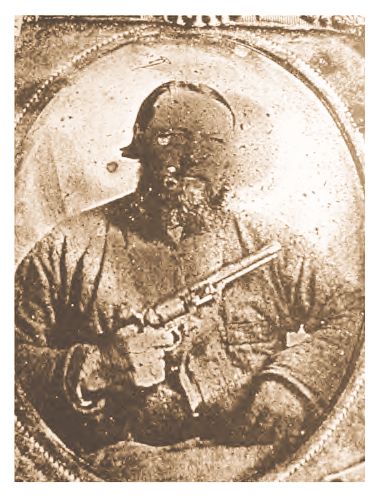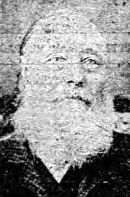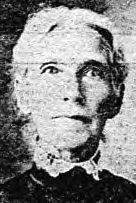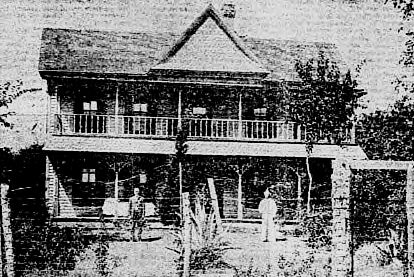
TREES

[Background and bio of Crawford TREES from The Dallas Morning News]
Crawford Trees Sr. was born in Union County, Illinois; a literate
single man, he migrated to the Republic of Texas in 1845 (which joiner
the Union that same year) at the age of 22. He rode on horseback from
Illinois and settled adjacent to the Kimmel tract which was located
about fifteen miles south of the John N. Bryan site. Crawford Trees and
the Kimmel family were the first white people to settle west of the
Trinity River. Both Crawford and Anna Minerva Kimmel were born in Union
County, Illinois but traveled separately in 1845 to settle in Texas and
were to meet for the first time in Dallas County were they were married
on 22 July 1846. Their marriage is the first documented and recorded
marriage license in Dallas County.Their original farm site lies on the
highest geographical location in North Texas - the white chalk bluff
escarpment. It was wooded with cedar trees; rich black soil produce
cotton and natural springs provided water. Ten Mile Creek begin
adjacent to their home site where their first log cabin was built.
Crawford went to the Red River for his milling. Indians were frequent
visitors but did little harm. By the year 1849 they had secured the
land grants to their properties by fulfilling their contractual duties
to Peters Colony which required that they establish, clear, and produce
their land in three years.In 1849 Crawford left his wife and family
with several negro slaves, livestock and rode on horseback to the
California gold rush. He returned in 1851 with rope spun furniture,
several thousand dollars in gold, and gold pocket watch and chain, and
a horse; many of these items have been donated to a museum built by the
Cedar Hill Historical Society on the original home site. Before his
death in 1889, he had acquired 5,458 acres of land and deeded to each
one of his children a farm of 160 acres, and at his death left all of
his possessions to his widow. He lived to see a wild prairie, inhabited
mostly by wild animals, converted into one of the finest farming
sections of the State. Anna and Crawford were buried at Trees Cemetery,
Cedar Hill, Texas, which was established by Crawford on 21 August 1856
and has remained under the auspices of his descendants.
Peters Colony
Duncanville is west of the intersection of Interstate Highway 20 and
U.S. Highway 67 in southwestern Dallas County. The land on which the
city lies originally belonged to the Peters Colony.qv Settlement began
when Crawford Trees arrived from Illinois in 1845 and purchased several
thousand acres south of Camp Dallas.
Dallas Morning News 1919


Story of the First Couple
By Mildred Gladney
Married in Dallas County
The cool of the summer twilight lay about them. The dog slept at their
feet. The old man gazed close at the print of his newspaper as the
light waned, and his wife sat quiescent, idle, dreaming, perhaps, of
the years of activity which had been left behind. The fruitful acres,
upon which decades of labor had been put by the family, surrounded
them. And, the story of this man and woman, who were born and who grew
to maturity, and, in time, established a home of their own in Dallas
County, is the history of the county itself, and of many others who
have seen Dallas grow from a ford in the Trinity River, to a prosperous
city.
Mrs. Jess Ramsey, nee Trees, is one of the ten children of Mrs. Anna M.
Trees and Crawford Trees, who were the first couple ever married in
Dallas County. This marriage took place in the days when there was no
courthouse, and the office of Justice of the Peace was a hazardous
position. But, the license was issued to Miss Anna Kimmel, whose father
had come pushing across the Texas prairies with his little family and
all his worldly possessions stowed away in a homemade wagon, and
Crawford Trees, whose parents entered Dallas County in the fall
following the immigration of the Kimmel family in the spring, on July
23, 1846.
No Wedding Journey.
The bride was not honored with showers and did not wear a going-away
suit of blue tricotine. She had made her own dress of homespun.
Afterward, they made their way through the undergrowth and the slight
woods between the log cabin, in which their parents lived at Cedar
Hill, to that which was to be their home. There was no wedding trip for
the first couple married in Dallas County, for trips in those days were
more strenuous than the ordinary course of existence. Their furniture
was improvised from the materials at hand, and several pieces were
given them by their parents. The log cabin, the floor of which was made
from logs split in half by the men of the families of the bride and
bridegroom, was not large, but it housed, comfortably, all of the
worldly goods of the two young people taking up life within its walls.
They were not within calling distance of their parents, but
communication was comparatively easy, even in those hard times. In the
days that followed, they took up the life of the pioneer, as they had
known it from childhood. Instead of helping his father to clear the
trees from his land, Crawford Trees began on that which he had
appropriated for himself. He was the head of a family, and their
welfare depended solely upon the fruition of the acres about them.
Instead of helping her mother to spin and weave for her brothers and
sisters, Anna Trees now had her own spinning machine and spun for her
husband and kept the house.
Civil War Breaks Out.
The virility of the life that followed, with its goodly portion of
monotony, and its difficulties, did not daunt the family. It grew
steadily, and at the outbreak of the Civil War, there were ten
children. Crawford Trees gathered his old rifle and his knapsack
together and went off to the war, leaving his wife to look after the
ten children and to manage the farm and the negroes. After a year, he
was back, with his health so impaired, that Mrs. Trees still continued
the work of the farm and cared for the family. And, with the sturdy
little boys who were growing up, she managed well. The father died in
1889. The boys and girls grew to maturity, married and moved to new
cabins about her. Eight of the children made their homes near Cedar
Hill, and their children, and their grandchildren, have also made their
homes in Dallas County. Mrs. Trees died about six years ago at the home
of her oldest daughter, Catherine, Mrs. Jess Ramsey, after seeing
numerous grandchildren ready to take up the work of cultivating the
fruitful acres, which she had taken out in the days when Dallas was
marked by a ford in the Trinity River, and Bonham was the only
settlement on the Red River.
Still at Cedar Hill.
And now, this daughter of the first couple ever married in Dallas
County has grown old on the land of her parents, within sight of the
old homestead. But, her declining years are spent in a modern
farmhouse, which has water piped to it from a cistern that is never
exhausted. The screens keep out the flies and other insects, which she
remembers her mother kept away with leaf brushes. The woods are gone,
and in their stead, plowed acres and huge haystacks, and a pike road,
upon which the modern knowledge of engineering has been expended, are
to be seen from her front porch. Her front lawn is mowed with a lawn
mower. Her children visit her in automobiles. And, in the calm of the
summer evenings, when the work on the farm is done for the day, she
sits on the porch of her home and thinks of the days when her mother
ran the farm and her father was at war.
"During the war," she said, "we used to go across the river on
horseback and take our wool to be carded, for we made all of the
clothes we wore at home. There was one little store and several
log-houses and a blacksmith shop. The goods we got at the store were
brought in ox wagons from Houston or down the Red River from Jefferson.
We saw the first brick house go up, and we saw the Indians disappear,
going farther and farther away from the settlements of the whites.
Troubled by Indians.
"I can remember hearing my mother tell about the time when she hid
several protesting babies away between the feather beds and stood at
the door with the shotgun as the Indians approached. When I got big
enough to remember, there were too few of them for us to have any
trouble. The only thing they bothered us about was the horses. We
simply couldn't keep any. One of our neighbors tried putting iron
hobbles on the feet of his horses so they couldn't drive them away.
But, the Indians just cut off the feet of the horses and went their
way, when they found they couldn't get them.
"First Negroes Ever Saw."
"I can remember, too, the first negroes I ever saw. My father returned
one night and brought with him some slaves. I was asleep, and the next
morning, when I waked up and crawled out of bed, I saw two little negro
girls asleep on a pallet at the foot of my bed. They like to scared me
to death, and then they got funny to me, and my father couldn't get me
away from them. We kept those negroes, I guess, until the war was over.
They stayed with us for about a year afterward, and then they went.
"Mr. Ramsey and I went to school together at the Bethel Schoolhouse. It
was opened in 1853, and Mr. Scott was the first teacher. Jess used to
come home with me after school, and we would take turns about grinding
the meal we used. You know, we would hollow out a stump and put the
corn down in that, and then grind it with a pestle. We didn't have any
flour at all. Mr. Scott was awful hard on us, and we were all scared to
death he would lick us. I don't believe Jess ever got a whipping at
school in his life. We studied writing and reading, and geography and
figures. I went to school at Lancaster, too. Then, when we grew up, we
married and started out life as my mother did, in a log cabin of one
room. We added to it, later, and had two rooms, and then we got this.
We have just three children.
"Our children are all grown and married now, and we are worse off than
when we started. Sometimes, I believe ten wasn't any too large a family.
Old House Still Standing.
"We had 1,200 acres here to start with, but we gave all but 200 of it
to our children as they grew up and married. We have a little grandson
about 6 years old, who goes to school in Dallas to Miss Edna
Washington. She is teaching him how to talk without hearing. My mother
died when he was about a month old. She lived here with us until then.
You can see the old home place. It is the first two-story house on the
main road toward Dallas from here. Our children live up there on the
pike, too, but we like it back here where it's quiet. How did you get
that gate open when you came in? That's a patent lock we got on there."
"No, we haven't any car. Wouldn't know how to drive one, if we had it,
but our daughter has one, and she comes up here in it. Get down; get
down, dog. She'll put her muddy feet on you, if you let her. Come back
and see us and spend the day some time. We'd be glad to have you."-
July 13, 1919, The Dallas Morning News,
Magazine Section, p. 4.
